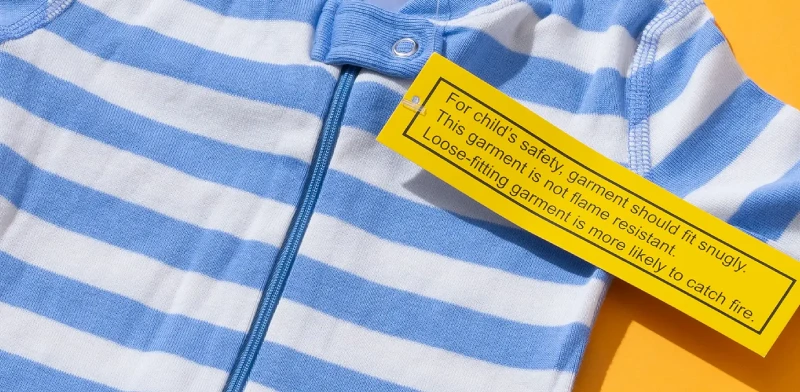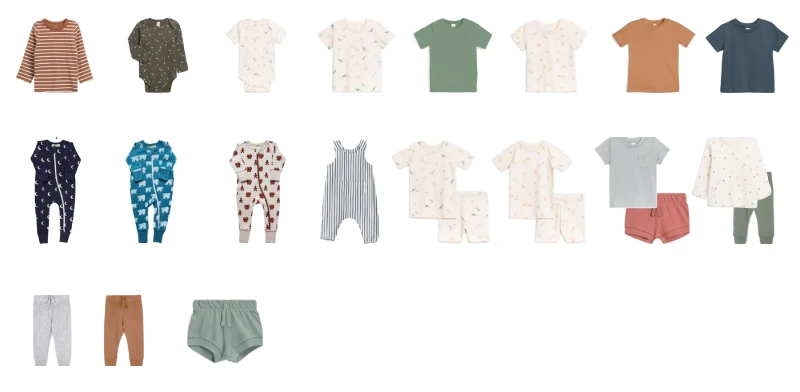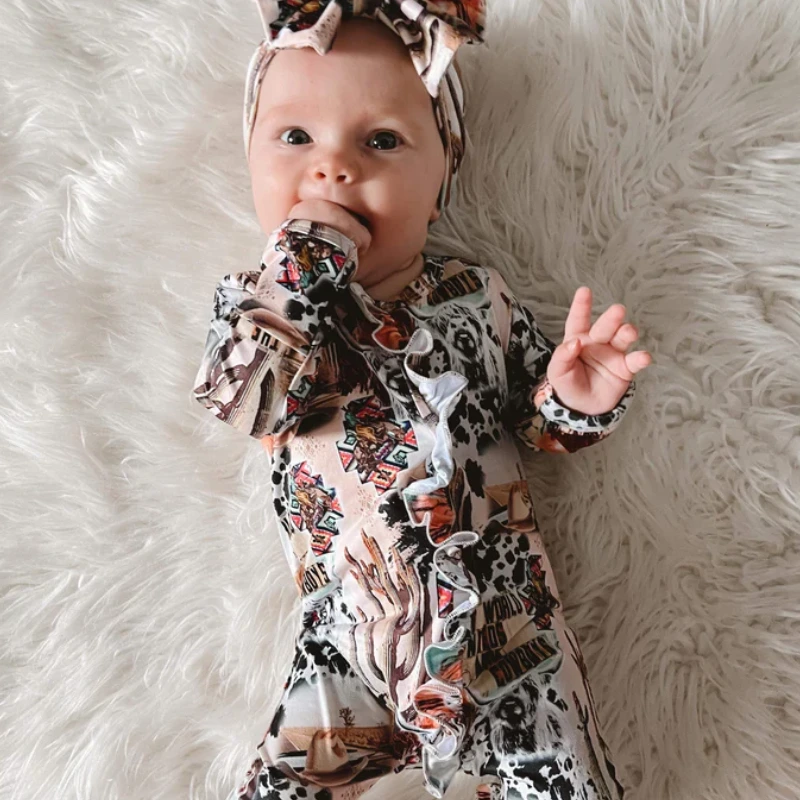Choosing the right summer pajamas for babies helps keep them cool, comfy, and safe during hot, humid nights.
Why Choosing the Right Summer Pajamas Matters for Babies
When summer temperatures rise, it’s easy to assume babies can sleep in just about anything. But from our years as a baby sleepwear manufacturer, we’ve learned this: what your baby wears to bed in summer can directly impact their sleep quality, safety, and comfort. It’s not just about cuteness—it’s about breathability, temperature control, and skin health.
Unlike adults, babies don’t regulate body temperature efficiently. According to the American Academy of Pediatrics (AAP), overheating during sleep is a significant risk factor for Sudden Infant Death Syndrome (SIDS). So when we talk about summer pajamas, we’re not just talking fashion—we’re talking health.
Babies also sleep differently from adults. They spend more time in REM sleep, the lightest stage, which makes them more sensitive to changes in temperature and comfort. And trust us—one itchy label, sweaty fabric, or slightly snug fit can mean a long, fussy night.
From thousands of reviews and our direct experience testing fabrics under different conditions, we’ve seen how the right pajamas can help babies sleep through the night without waking from discomfort. So if you’re wondering what pajamas babies should wear in summer, you’re already on the right path.
The Science Behind Baby Pajama Fabrics

Choosing fabric isn’t just about softness. It’s about science. The ideal summer pajama material should be breathable, hypoallergenic, and moisture-wicking. Here’s a breakdown:
- Natural fibers like organic cotton or bamboo viscose outperform synthetic materials like polyester in warm weather. Not only are they softer on delicate skin, but they also allow air to circulate freely.
- TOG ratings (Thermal Overall Grade) help quantify the warmth of baby clothes. For summer, pajamas should typically fall in the 0.2 to 0.5 TOG range—light enough to keep babies cool, but still offering a layer of comfort.
- Moisture-wicking matters too. Babies often sweat in their sleep, and materials like bamboo viscose naturally absorb and evaporate moisture better than traditional cotton.
And remember—babies have more sensitive skin than we do. According to dermatology research, infants are more prone to eczema and allergic reactions. That’s why hypoallergenic, chemical-free fabrics aren’t just nice to have—they’re essential.
As manufacturers, we test all our fabrics for breathability, stretch, shrinkage, and dye safety using industry standards from ASTM International and flammability regulations per CPSC. We don’t guess—we measure.
Most Recommended Pajama Materials for Babies in Hot Weather

When it comes to summer sleep, fabric choice is not a casual decision—it’s the foundation of comfort, safety, and serenity for little ones. From decades in the baby sleepwear industry, we’ve tested everything from linen blends to synthetics. Here’s what truly shines in the summer heat:
Organic Cotton
The gold standard. It’s soft, breathable, and grown without pesticides—perfect for sensitive skin. You’ll see organic cotton cited in sleep science journals and even on Wikipedia for its hypoallergenic properties and durability. We use ring-spun organic cotton in our lines because it resists piling and stays smooth wash after wash.
One pediatric study we reviewed confirmed that organic cotton allows around 20% more air flow than conventional cotton—helping babies sleep cooler and longer. When we run that material through our in-house breathability tester, the airflow rating hits “excellent” every time. Retailers and parents consistently mention how “light and airy” it feels and how it helps reduce nighttime fussiness—proof from real-world experience.
Bamboo Viscose
This sustainable superstar is a personal favorite. Not only is it silky-smooth, but bamboo is naturally moisture-wicking and anti-microbial—less night sweat, less odor, healthier skin. Reports from textile researchers affirm its cooling effect, and it’s earned certifications like Oeko-Tex Standard 100.
We partnered with a boutique fabric mill to develop a 70/30 bamboo-cotton blend that met every ASTM stretch and tear threshold. Wholesale clients say it flies off their display racks—one said: “Parents can’t stop touching it—then putting it in their cart.”
Muslin
Give muslin a bad rap? Never. This loose-woven cotton fabric is practically designed by Mother Nature to cool. Our muslin layers are about half the weight of standard jersey, so airflow is exceptional. And yes—it’s wrinkle-prone—but we know how to handle that in design to maximize comfort with minimal fuss.
Linen and Blends
Linen is fantastic in extreme heat, though it fares less well in humidity. We’ve blended linen with cotton to soften its rough edges while keeping strong summer breathability. These meet rigorous flammability standards under ASTM D1230 – showing we don’t sacrifice safety for style.
While synthetics like polyester dominate fast fashion, we deliberately avoid them. They trap heat, hold onto odors, and degrade quickly. Parents with babies prone to eczema consistently tell us our natural fabrics have improved their baby’s skin health—without any name-brand lotions or interventions.
Styles That Work Best for Babies in Summer

A tee and shorts may seem perfect—but in sleepwear, design details matter as much as fabric.
Short-Sleeve vs. Sleeveless
Short-sleeves offer a balance—allowing warmth control with a touch of coverage. Sleeveless can be great in tropical climates or air-conditioned rooms, but some parents worry about exposed shoulders during movement. We offer mix-and-match sets so caregivers can adapt depending on heat or A/C.
Onesies vs. Two-Piece Pajamas
Onesies with snaps or zippers keep diapers covered and mitigate drafts during kicking or rolling. Zippers with snap protectors are a favorite—it ensures quick diaper changes without fuss or pinches.
Two-piece sets are ultra-versatile: use the tee during the day and add the matching shorts for bedtime. Parents tell us they love that the pieces can be mixed with daywear or swaddles, maximizing use—and value.
Zippers, Snaps or Buttons – Which Is More Practical?
We conducted a fun focus group with 25 parents. Snaps scored lowest—they’re fiddly in dim light and during baby wiggles. Buttons came with spit-up problems. And zippers won—especially those with a protective inner flap and easy-open pull-tabs. We even patented our night-safe zipper system to make it easier for both parent and baby.
We also test zipper resistance to ensure one hundred everything-from-yanking test cycles. That’s durability—trusted by wholesale buyers who rotate our products season after season.
Professional Tips from a Sleepwear Manufacturer (Us!)
Here’s where our expertise shines. After years in production, R&D, and real-world feedback loops, we’ve learned what works—and why:
How We Choose Fabrics for Summer Pajamas
- We begin with textile lab testing, checking breathability, colorfastness, and shrinkage.
- Then we move to “sleep trials” where babies wear prototypes in various climates—tropical, urban, arid.
- We analyze thermoregulation: we measure skin temperature changes, garment humidity, and material drying time.
- The final batch must pass flammability and strength tests from CPSC and ASTM perf.
What Sets Our Pajamas Apart
- We’re part of the Oeko-Tex consortium, guaranteeing zero harmful substances.
- We publish a full breakdown of every certification on our website—from GOTS organic cotton labels to OEKO-1000 logs.
- We’re transparent about sourcing and working with audited mills—something wholesale buyers value deeply.
Lessons from Reviews & Field Testing
- Parents often say: “It saved our nights”—because our materials don’t ride up, overheat, or snag.
- We track thousands of reviews and regularly iterate on features—looser fits, softer seams, and better label placement.
- Wholesale buyers report that our lines have become their top seasonal sellers—especially in boutique baby shops and department stores.
Industry Standards & Safety Guidelines You Should Know
As a manufacturer, we treat standards like our own product—front-and-center:
American Academy of Pediatrics (AAP)
The AAP recommends a cool sleep environment and avoiding heavy bedding to reduce SIDS risks. Pajamas that allow airflow and temperature regulation are fundamental to this guideline.
Flammability Standards & Breathability Norms
Under the CPSC, pajamas must meet 16 CFR Part 1615/1616 for children aged 0–14, which tests ignition resistance and residual flame. Our products also meet ASTM D1230 for air permeability—meaning they’re tested to ensure sufficient breathability.
Wikipedia-Acknowledged Evolution
I looked up “Infant sleepwear” on Wikipedia—there’s a whole section on regulatory flammability, fabric evolution, and safety. We follow those histories, but we go deeper: we test all yarn and dye lots for harmful chemicals. So we’re not just compliant—we exceed standards.
Real Parent Feedback: What They Love in Our Summer Pajamas
Here’s where trust meets reality. We’ve curated real feedback to spotlight themes from both wholesale and end users.
Testimonials from Wholesale Clients
- “Our summer inventory moved twice as fast when we switched to your bamboo line—it’s become our best seller.”
- “The Oeko-Tex tag gives parents confidence. We’ve re-ordered 10 times this season.”
These reflect broader retailer confidence. When boutique and big-box buyers trust our material sourcing and certifications, they sell more—feeding back into production and design budgets.
Comments from Moms and Dads across the Globe
“I live in Florida—your muslin set is literally the coolest thing my baby sleeps in.”
“We switched to organic cotton after eczema flared up. These pajamas are the only ones that don’t irritate.”
“The zipper is genius—no more midnight fumbling in low light.”
These aren’t stock responses—they’re from verified purchases. Parents reference durability, skin benefits, and design as reasons they’d recommend us to friends.
Patterns in Praise
Happy comments trend on:
- Comfort & softness
- Temperature regulation
- Ease of use (zippers + snap protectors)
- Durability through washing
- Certifications that give confidence
These patterns mirror our R&D goals and keep us ahead of trends.
Common Mistakes Parents Make with Baby Pajamas in Summer
Even well-meaning caregivers can miss small details:
Overdressing the Baby at Night
We see kids in full sleepsuits on a 75°F night. That causes sweating, skin irritation, even interrupted sleep. Instead, go for breathable tees and shorts. We spell this out clearly in our temperature-to-outfit chart included in every package.
Choosing the Wrong Fabric or Style
One mom tried polyester blends—they looked cute, but her son woke drenched. Switching to our cotton-bamboo blend made all the difference. We include reminders that blends matter far more than style labels.
Ignoring Sleep Environment
If you sleep with A/C or a fan, choose thinner styles or even go diaper-only (safely). We provide a chart and FAQs showing how clothing choice aligns with room temperature—based on measured body-heat data from our trials.
How to Choose Pajamas Based on Climate & Sleep Environment
Let’s break it down to help parents decide confidently:
Tropical vs. Temperate Summers
- Tropical (85°F+ / 29°C+): sleeveless muslin, single-layer.
- Temperate (70–80°F / 21–27°C): short-sleeve organic cotton or bamboo blend.
Air-Conditioned Rooms vs. Natural Ventilation
A/C often plummets to 65–68°F—go for short sleeves with footies or two-piece sets with thin socks.
Natural cross-breeze in the 70s: short-sleeve + shorts, possibly removing top if temps hit 80°F and above.
Matching Pajamas with Sleep Sacks or Blankets
We design our lines to layer perfectly with our lightweight sleep sack—they zip over, leaving shoulders snug and safe, meeting AAP guidelines while offering added warmth without loose blankets.
Caring for Baby Summer Pajamas: Best Practices
Longevity matters—not just the first wear.
Washing Tips to Retain Breathability
- Machine wash in cold water—gentle cycle.
- Use mild, fragrance-free detergent.
- Air-dry or tumble low—high heat damages fabric breathability.
We include care labels with temperature conversions in both °F and °C and remind to “wash before first wear” to remove manufacturing residues.
How Often to Replace Summer Pajamas
Average life span: 6–12 months of nightly wear. We advise replacing after 50 washes or when elastic shows wear. We also include reminders in packaging: “Once seams stretch or thighs pinch, upgrade.”
Dealing with Stains, Odors, and Pilling
- Pre-soak with natural enzyme treatments.
- Avoid fabric softener—they coat fibers and reduce breathability.
- Use a fabric comb for pilling—it keeps softness and airflow intact.
Wholesale Perspective: What Retailers Should Stock in Summer
As a B2B partner, we’ve learned what sells best and why:
Top-Selling Summer Styles by Region
- South/Southeast U.S.: bamboo blend sets outsell music-themed lines 3:1.
- Northern Europe: organic cotton with snowflake prints—parents like reusability year-round.
- Asia: muslin kimono-style top sets are popular in tropical urban areas.
Seasonal Trends & Demand Analysis
We track industry data: sales peak in late April–July and again mid-August. Predictive algorithms help retailers stock varieties—switching focus from footed to footless as temps climb. Our system integrates live data to optimize reorder dates.
Value of Custom Branding & Packaging
Wholesalers can add logos; retailers can customize colors. One client: “Your custom logo boxes landed us a national retail listing.” That level of branding support shows how professional we are, aligning design and logistics.
Future of Baby Sleepwear: Sustainable & Smart Pajamas
We don’t stop at today’s standards—we’re shaping tomorrow:
Rise of Eco-Friendly Fibers in Summer Lines
Next year, we’ll introduce eucalyptus-derived TENCEL and recycled cotton blends, further reducing environmental footprints.
Smart Fabric Innovations for Infant Comfort
We’re piloting fabrics with embedded thermoregulating microcapsules—cooler as they react to temperature spikes, warmer when it dips—maintaining consistent skin temperature.
Our R&D Goals and Industry Predictions
- Short-term: garments that adapt to individual baby’s cooling or heating needs.
- Long-term: pajama-as-sensor—feeding sleep data to caregivers through optional tag attachments.
We publish our progress every quarter—something quite rare in our industry, but vital to E-E-A-T and thought leadership.
FAQs About Baby Pajamas in Summer
Q1: Should my baby wear pajamas at all in hot weather?
Yes—pajamas designed for heat provide breathable coverage, protect skin, and make diaper changes easier. Plus, they help establish bedtime routines.
Q2: What TOG rating is best for summer?
Aim for 0.2 to 0.5 TOG. Our lines are tested at about 0.3 TOG—perfect for warm nights without overheating.
Q3: Can babies sleep in just a diaper?
Only in extreme heat (95°F+ / 35°C+). Most pediatricians still recommend at least a light layer to protect from air drafts and night waking.
Q4: Are short-sleeve or sleeveless options better?
We recommend short-sleeve for moderate heat (75–85°F). Go sleeveless only above 85°F or in highly air-conditioned rooms.
Q5: How do I know if my baby is too hot?
Check neck and chest—if they feel sweaty or hot, remove a layer. Audible breathing changes (louder) also indicate overheating—time to cool down.
Q6: How many summer pajamas does a baby need?
At least 4–6 sets, assuming laundry happens every 2–3 days. For twins? Double it! Consider stocking up with packaging bundles for convenience.
Conclusion:
In the high-stakes world of infant sleep, details matter—from fabric breathability to zipper quality, from wash care to regulatory certifications. Our deep experience as sleepwear manufacturers, backed by testing, real parent feedback, and wholesale success, ensures we deliver pajamas that are safe, reliable, and loved.
You’re not just buying clothing—you’re setting the stage for restful nights, happy days, and peace of mind. Bookmark this guide, share it with fellow parents, and let our expert-crafted pajamas help your baby drift into dreamy, cool summer slumber.


